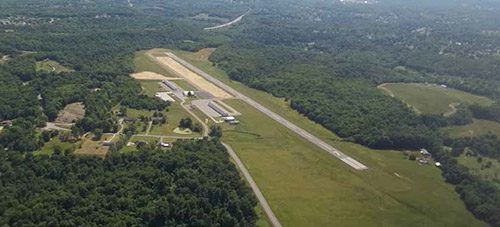 Columbiana County Airport is a small two-runway facility in rural Ohio with 28 aircraft based on the field. But that doesn't stop it from providing high-speed Internet access to its customers. The airport secured the much-needed, but costly-to-add, service through a barter arrangement with a nearby Internet provider.
Columbiana County Airport is a small two-runway facility in rural Ohio with 28 aircraft based on the field. But that doesn't stop it from providing high-speed Internet access to its customers. The airport secured the much-needed, but costly-to-add, service through a barter arrangement with a nearby Internet provider.
The airport allowed RAA Services to install equipment on its beacon tower – the highest point in the
|
factsfigures
Project: Internet Service Location: Columbiana County (OH) Airport Cost: Airport receives free Wi-Fi service for allowing Internet provider to install equipment on its beacon pole; community members pay $30/month Internet Provider: RAA Services Benefits: Online flight plan filing & access to real-time weather reports for pilots; opportunity to purchase previously unavailable Internet service for airport neighbors |
area – in exchange for free broadband Internet service. Previously, the airport had an Internet subscription to an expensive satellite service, notes Mike Diloreto, chairman of the Columbiana County Airport Authority.
"At our location, there is no cable or offering," he says.
The creative arrangement also benefits the surrounding community, as local residents and businesses gained the previously unavailable opportunity to purchase Internet service for $30 per month.
Requests for service from several community members, in fact, initiated the deal. When RAA realized it didn't have the necessary equipment in place to service the area, Scott Dunn, the company's chief executive officer, asked the airport for access to its light tower.
Often, RAA mounts equipment on farmers' grain bins or silos to obtain a line of sight to an antenna, but the airport's light pole was tall enough to send a signal over the tree three miles away and relay an Internet signal back to customers in the area. It was also already wired for electricity.
"This was the perfect and most logical choice," explains Diloreto.
After Dunn's initial conversation with Diloreto, the project was completed in about nine months, and a whole new world opened up to Columbiana County Airport and its neighbors via the World Wide Web.
Strong Connections
Everyone is pleased with the small-town airport's unique approach to staying relevant and progressive, says airport authority member John Sayle. The facility's original development apparently followed a similar theme, when former governor Jim Rhodes decided to establish airports in all 88 of Ohio's counties back in the 1960s. Sayle characterizes Rhodes as progressive for recognizing the importance of local airports for economic growth. Columbiana County Airport was developed from a small grass-strip facility established in the 1920s just outside of East Liverpool. "We have been really fortunate to get many grants over the years to develop our airport," Sayle notes.
With today's economic challenges, Sayle recognizes the airport as an advantage for the area and acknowledges the importance of access to the World Wide Web for its users. The airport's high-speed service allows based customers and transient pilots to access up-to-the-minute weather briefings and file plans with the FAA.
"These are all ways of communicating and gathering information for a safe flight," he says. "If an airport doesn't have access to the Internet, it really handicaps its efficiency."
Initially, Dunn thought of this opportunity as a way to connect more local customers to the Internet. But after he spoke with airport representatives and learned about the facility's lack of Internet service, he quickly realized the space-for-service swap would also help the airport.
Previously, the only way the airport could accommodate incoming/outgoing pilots, he says, was paying for Wi-Fi with a cellular phone card or a satellite connection, both of which are costly, as the airport knew firsthand. Plus, those options limited the bandwidth available, and added potential overage charges. "When a pilot flew in and looked for a Wi-Fi signal, he would realize there's nothing there," says Dunn. "The problem is (that) more and more of everything done in this world is via the Internet."
Community Service
"Everybody came out ahead on this one," comments Diloreto. "It has to do a lot with aviation; but in this case, we were able to reach out and help the surrounding area."
This type of attitude is important for, and appreciated about, a small hometown airport, he notes. Using its light tower to provide Internet to nearby local homes is a way to provide another level of service to those that support the airport.
"We try to be a good neighbor, and this just enhances that relationship," says Sayle.
Having an airport – especially a successful and accessible one – makes a difference when communities are looking to create jobs and attract new people, he explains. "If you don't have a place to land, they'll land somewhere else," says Sayle. But while an airport makes a county or town a competitor, it needs support to help it grow, he adds.
Dunn says that if the airport had sought him out, rather than vice versa, the high-speed Internet signal could have been working in Columbiana County Airport's favor years ago. Consequently, he suggests that small, rural airports contact their local wireless providers to see if a similar deal can be reached.
"Partner with an Internet service provider," Sayle suggests. "Airports are big open spaces." He says that the Internet swap is just one of many ways this rural airport has made forward-thinking developments, and why it is considered a key facility in Eastern Ohio. Just this August, a $45,000+ grant was awarded to Columbiana County Airport for taxiway and apron improvements.
With service in place for nearly a year, Dunn hasn't received a single complaint. "It's been great for the airport," reports Diloreto.
"We had the electricity; we had the altitude. It was a great idea," Sayle concludes.


